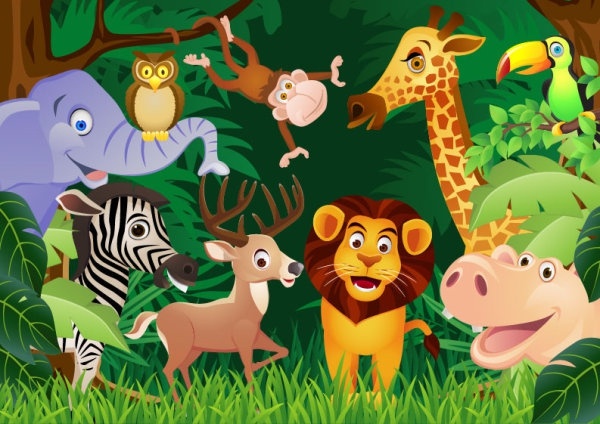Anchor Grade-Level Standards:
LS1.A: Structure and Function… Different animals use their body parts in different ways to see, hear, grasp objects, protect themselves, move from place to place, and seek, find, and take in food, water, and air.
W1.7: Research to Build and Present Knowledge: Participate in shared research and writing projects.
ISTE Standard: Knowledge Constructor - Students critically curate a variety of resources using digital tools to construct knowledge, produce creative artifacts and make meaningful learning experiences for themselves and others.
Lesson Plan
Objective: Students will use a variety of text sources (print and digital) to research an animal of their choosing, about the animal’s appearance, food sources, home, and abilities by writing a paper and creating a project about the animal.
Need to Know: Teacher will present students with an informational video about animals, their habitats, and how these animals interact with each other. Students will engage in a discussion with a partner or group, then with whole class, about what information they found interesting about specific animals, their appearances, their abilities, and their homes.
Driving Question: Teacher will guide students to have further discussion and brainstorming sessions regarding the overall driving question, What physical body parts of my favorite animal allows it to have certain abilities, eat certain food, and live in certain homes? Teacher will present students with the project tasks at hand: using a variety of print resources (books, internet sources) create a Thinking Map, write a paper, and create a physical or digital project about your animal.
Student Voice and Choice: Students work together to brainstorm their favorite animals, what resources they might use to learn more, what Thinking Maps lend themselves to this project, and what possible projects they could come up with as a culminating display of their research.
21st Century Skills: Teacher works with students to come up with a list of appropriate digital resources, and how to find them, and provides tutorial when necessary. They are also guided through the skills needed to check out age-appropriate, readable library books about their animal. Students work in groups based on their animal habitat, to help each other research and organize information. Teacher provides students with Thinking Map templates, and students have group discussions about which Thinking Map might work best to organize their information. Teacher also provides students with a digital copy of Thinking Map templates, and students have the option to type information into maps on a Google Doc. Students will also work together to brainstorm different ways to create physical (i.e., drawings, paintings, sculptures from clay or recycled materials) or digital (i.e. digital art, PowerPoint/PowToon/Prezi using photo research) representations of their animals.
Inquiry and Innovation: Students have group discussions about the similarities and differences between their animals, first within their habitat groups, then with members of other habitat groups, and finally with the entire class, with teacher guiding them to organize this information.
Feedback and Revision: Together as a class, teacher and students work together to make a rubric to track their progress and final product completion. As a team, the class works together to decide what a finished product that has met all expectations might look like. Teacher has progress-monitoring conferences with each student over the course of study to see how their work is coming along. Students also progress monitor each other amongst their habitat teams. After the final product is presented, teacher has a final conference with each student, using class-created rubric, to determine child’s final grade on project. The conferences between teacher & students as well as students & students can be monitored and recorded digitally via Google Docs.
Publicly Presented Product: Students will have an “animal fair,” in which students and teachers from other classes, as well as parents, can come to see their final projects, and they can orally present information they have learned.
Rubric
Needs Improvement
|
In Progress
|
Meets Expectations
| ||
Group work and collaboration
|
Student had challenges getting along with group members and contributing to discussions.
1-3 pts.
|
Student got along with group members for the most part, and contributed to some discussions.
4 pts.
|
Student got along well with all group members and contributed to all discussions.
6 pts.
|
__/6 points
|
Research
|
Student did not use resources in research.
0 pts.
|
Student only used 1 resource in research.
2 pts.
|
Student used 2+ resources in research (1 digital).
4 pts.
|
__/4 points
|
Thinking Map
|
Student did not use Thinking Map.
0 pts.
|
Student’s Thinking Map did not correlate to written paper.
2 pts.
|
Student’s Thinking Map directly related to structure and content of written paper.
4 pts.
|
__/6 points
|
Paper
|
Student’s paper does not include information about animal’s appearance, abilities, food sources, or habitat.
0-1 pt.
|
Student’s paper includes 1-3 categories of information about animal’s appearance, abilities, food sources, or habitat.
2-6 pts.
|
Student’s paper includes all 4 categories of information about animal’s appearance, abilities, food sources, or habitat.
8 pts.
|
__/8 points
|
Project
|
Student does not complete culminating piece.
0 pts.
|
Student’s culminating piece does not physically or digitally represent animal.
2 pts.
|
Student’s culminating piece physically or digitally represents animal.
4 pts.
|
__/4 points
|
__/18 points
|



Comments
Post a Comment